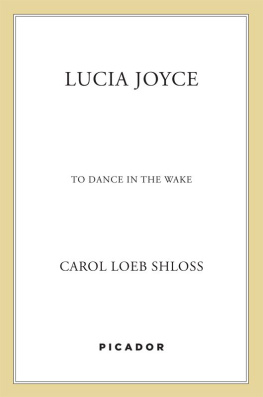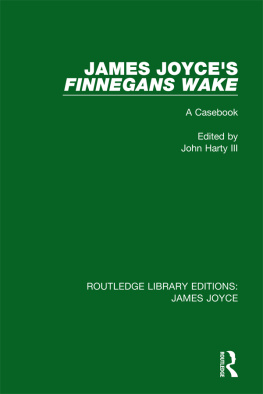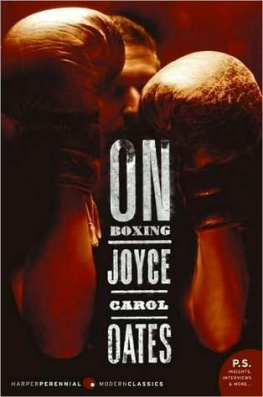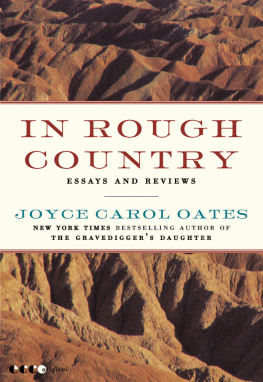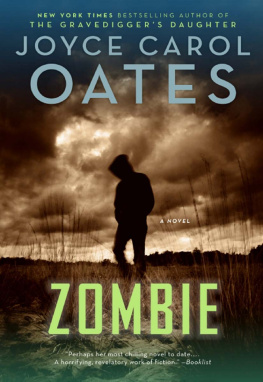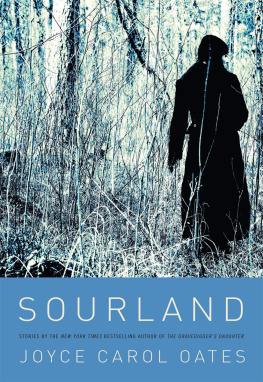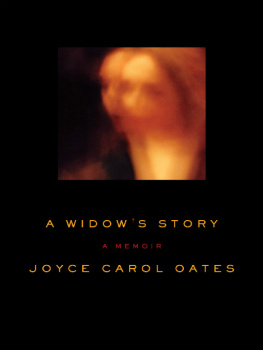Carol Loeb Shloss - Lucia Joyce: To Dance in the Wake
Here you can read online Carol Loeb Shloss - Lucia Joyce: To Dance in the Wake full text of the book (entire story) in english for free. Download pdf and epub, get meaning, cover and reviews about this ebook. year: 2005, publisher: Farrar, Straus and Giroux, genre: Detective and thriller. Description of the work, (preface) as well as reviews are available. Best literature library LitArk.com created for fans of good reading and offers a wide selection of genres:
Romance novel
Science fiction
Adventure
Detective
Science
History
Home and family
Prose
Art
Politics
Computer
Non-fiction
Religion
Business
Children
Humor
Choose a favorite category and find really read worthwhile books. Enjoy immersion in the world of imagination, feel the emotions of the characters or learn something new for yourself, make an fascinating discovery.
- Book:Lucia Joyce: To Dance in the Wake
- Author:
- Publisher:Farrar, Straus and Giroux
- Genre:
- Year:2005
- Rating:4 / 5
- Favourites:Add to favourites
- Your mark:
- 80
- 1
- 2
- 3
- 4
- 5
Lucia Joyce: To Dance in the Wake: summary, description and annotation
We offer to read an annotation, description, summary or preface (depends on what the author of the book "Lucia Joyce: To Dance in the Wake" wrote himself). If you haven't found the necessary information about the book — write in the comments, we will try to find it.
Lucia Joyce: To Dance in the Wake — read online for free the complete book (whole text) full work
Below is the text of the book, divided by pages. System saving the place of the last page read, allows you to conveniently read the book "Lucia Joyce: To Dance in the Wake" online for free, without having to search again every time where you left off. Put a bookmark, and you can go to the page where you finished reading at any time.
Font size:
Interval:
Bookmark:

The author and publisher have provided this e-book to you for your personal use only. You may not make this e-book publicly available in any way. Copyright infringement is against the law. If you believe the copy of this e-book you are reading infringes on the authors copyright, please notify the publisher at: us.macmillanusa.com/piracy.

TO ROB
But I, am I not a reminder of what you buried in oblivion to build your world?
L UCE I RIGARAY , Elemental Passions
Contents
INTRODUCTION
WHAT HAPPENED TO LUCIA JOYCE?
I. A FATHER, A DAUGHTER, AND THE WHOLE WIDE WORLD
Imagine a cacophony of voices. First came those who knew Lucia: I think that Lucias mind is deranged.
Next came the voices of the doctors who examined her: There is nothing mentally wrong with her now.
A generation later, the voices of the biographers chimed in: She was a tortured and blocked replica of genius; Everyone had a different opinion about what was wrong with Lucia Joyce. The label that stuck most often was schizophrenia. But in one way or another she has sifted down through the years as the mad daughter of a man of genius.
But she was not mad in the eyes of her father. James Joyce disagreed with everybody, and in this disagreement lies the heart of the story told in this book. No matter what happened to Lucia, Joyce did not lose sight of the beauty and talent of his child; he saw the pathos and desperation of her life; he learned from her, and he refused to abandon her. To him she retained the qualities that he had seen in her at birth when he had associated her with Dantes Beatrice: Once arrived at the place of its desiring, [the soul] sees a lady held in reverence, splendid in light; and through her radiance, the pilgrim spirit looks upon her being. To him she was Lucia the light-giver, the wonder wild. Thus whatever else we can say about Lucia Joyce now, so many long years after her death, we know that she was dearly loved. We know that she was greatly talented and that the story of her struggles, amid all its bitter contention, is one of the great love stories of the twentieth century.
It is also a story that will arouse debate. Reading this book is more akin to entering a labyrinth than to undertaking a windswept journey to a safe and easy harbor. Something was the matter with her, and in trying to identify the problem, Joyce and Lucia sometimes got lost; they took wrong turns; they wandered around, and then they would find the thread again and go on. They had helping figures; the help failed. They listened to advice; the advice proved futile. They went on, alone, and in the mind of the daughter their journey proved that she and her extraordinary father were stronger than all the doctors of Europe combined.
Neither father nor daughter knew that they were close to the truth. Madness isnt understood now; it was just as perplexing in Lucias lifetime, and love can be a strong medicine in the face of uncertainty. In the 1930s, psychiatry was as newly and awkwardly modern as the ungainly books that made James Joyce famous. There were no uniform diagnostic categories, and as Eugen Bleuler, the teacher of several of Lucias doctors, acknowledged, with many patients, the number of diagnoses made equals the number of institutions they have been to. Of what, then, did Lucias madness consist?
In the meantime, amid all the turmoil about what happened to her in later life, an important part of Lucias story got lost. People tended to forget that she, too, had been an artist, a dancer, who worked with a fervor and vision comparable to Joyces own. From a young age, she had shown a marked aptitude for sport, for physical culture, for dance. She studied modern dance; she studied for the classical ballet; she joined a performing troupe; she toured Europe; she danced in a Jean Renoir movie; she entered competitions and claimed the attention of one of Pariss leading dance critics. In judging a contest in 1928, Charles de Saint-Cyr spoke of Lucia as a very remarkable artist [with] totally subtle and barbaric powers.
By the time she was twenty-one, she was blazing with the same kind of discovery that had fueled the talents of performers like Mary Wigman and had convinced other young women of her generation that they were creating a new religion through the movement of their dancing bodies. The Paris Times, interviewing Lucia in 1928, noticed the Irish lilt in her voice and described her as tall, slender, remarkably graceful, with brown bobbed hair, blue eyes and very clear skin. She dances all day long, if not with Les Six de rythme et couleur, studying under Lois Hutton and Hlne Vanel then by herself. She never tires. When she is not dancing, she is planning costumes, working out color schemes, designing color effects. In the interviewers judgment, Lucia had Joyces enthusiasm, energy, and a not-yet-determined amount of his genius. He predicted that when she reaches her full capacity for rhythmic dancing, James Joyce may yet be known as his daughters father.
But the attention that people later paid to Lucias mysterious illness came to eclipse the nature of her own desires and achievements, making it seem as if her periodic outbursts of rage sprang up out of a blighted spirit for no discernible reason. Joyce knew differently. Eventually he came to see his daughters talent, to recognize her calling, and to understand the fury that she directed at the world. Lucia faulted her mother for discouraging her, her brother Giorgio for abandoning her, and, once Ulysses was acknowledged to be one of the masterpieces of world literature, her father for overshadowing her. Kay Boyle, who befriended Lucia in Paris during the height of Joyces fame, could also see that Lucias anger was specific and clearly directed. She remembered resentment as a constant theme of her friends youth: Giorgio and Lucia were bitter about their father, and agreed on the question of the crippling effect his fame had on their lives, she wrote to Jane Lidderdale in early 1983. What a book could be written about their anguish!
What happened to that lively radiance? Joyce watched the growing turbulence of his daughters personal relationships in Paris. Lucia became the lover of Samuel Beckett, Alexander Calder, and other young men of the expatriate community, the lesbian lover of Myrsine Moschos, Sylvia Beachs assistant at Shakespeare and Company, and friend of George Antheil, Darius Milhaud, and Kay Boyle. All of them commemorated her in their music and writing, but none of them re-created the complexity of her character more eloquently than her father did.
To him she served as a dark muse, whose life he saw in tandem with his own. Joyce considered Lucia to be wild, beautiful, and unsparingly truthful. As he strove to understand the passions that seemed to rule her conduct, he came eventually to see her as an unexpected but true heir to genius. In 1934 he wrote, Whatever spark or gift I possess has been transmitted to Lucia and it has kindled a fire in her brain.
A year later, in 1935, writing to Harriet Weaver, Joyce said that Lucia had a mind as clear and as unsparing as the lightning. She is a fantastic being, speaking a curious abbreviated language of her own. I understand it or most of it. His absorption in her fate colored the final years of his life, drawing him into the worlds of mime, dance, and surrealism and into reconsidering the performative nature of language as well as the fictional aspects of everyday life. Eventually, with her nervous breakdown in the 1930s, Lucia pulled him into the dark circles of psychiatric medicine in its early modern years. With the outbreak of World War II, he found himself engaged in a desperate struggle to outwit the bureaucracies of Vichy, German-occupied France, and Switzerland in a valiant but futile effort to save her from permanent institutionalization behind enemy lines.
Next pageFont size:
Interval:
Bookmark:
Similar books «Lucia Joyce: To Dance in the Wake»
Look at similar books to Lucia Joyce: To Dance in the Wake. We have selected literature similar in name and meaning in the hope of providing readers with more options to find new, interesting, not yet read works.
Discussion, reviews of the book Lucia Joyce: To Dance in the Wake and just readers' own opinions. Leave your comments, write what you think about the work, its meaning or the main characters. Specify what exactly you liked and what you didn't like, and why you think so.

